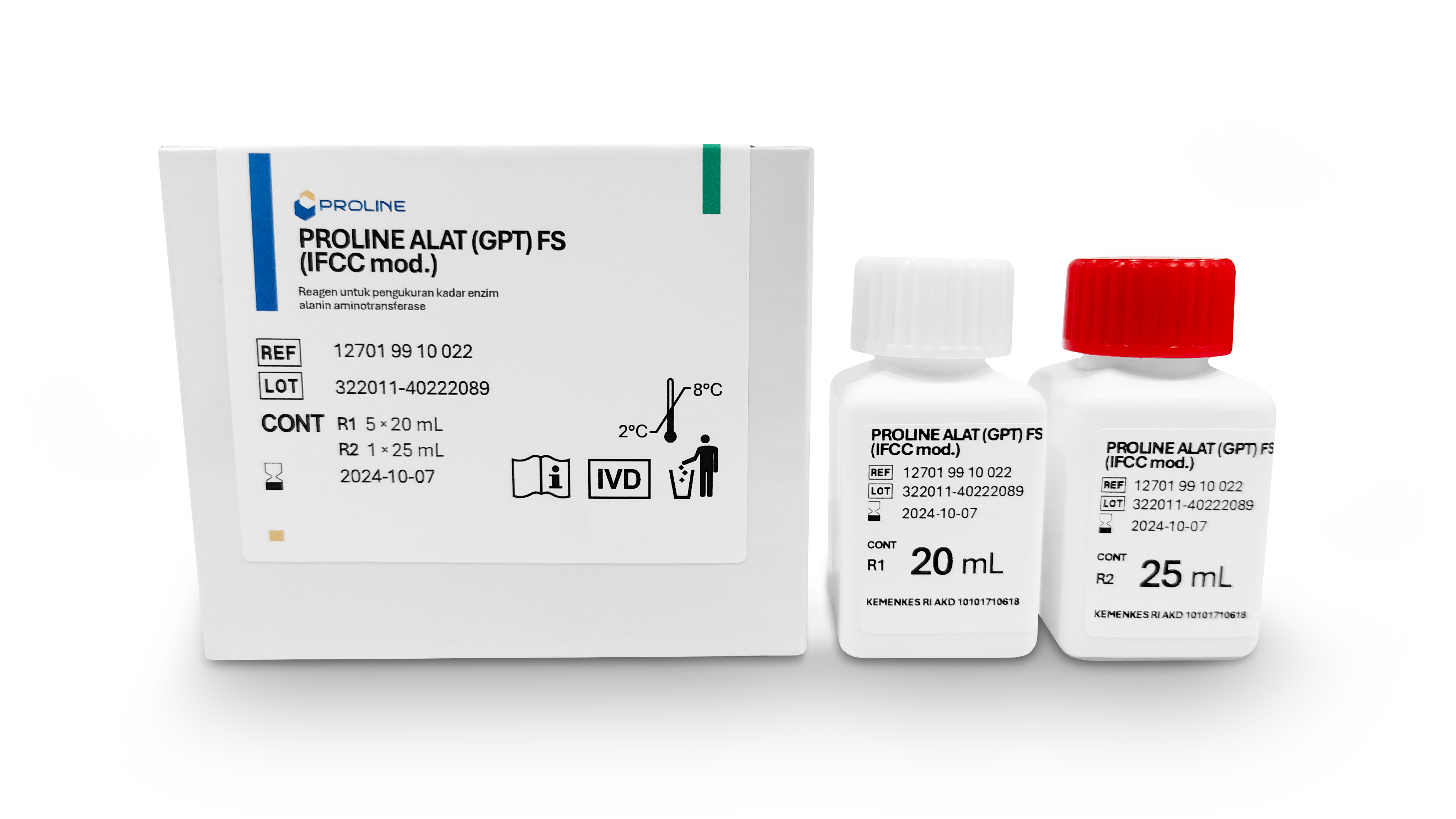PROLINE ALAT (GPT) FS (IFCC mod.)

| Catalogue Number | R1 Reagent Volume | R2 Reagent Volume |
| 12701 99 10 920 | 4 x 34 mL | 4 x 10 mL |
| 12701 99 10 921 | 4 x 21 mL | 4 x 6 mL |
| 12701 99 10 191 | 4 x 36 mL | 4 x 9 mL |
| 12701 99 10 022 | 5 x 20 mL | 1 x 25 mL |
| 1 2701 99 10 025 | 3 x 80 mL | 1 x 60 mL |
| 12701 99 10 029 | 3 x 200 mL | 1 x 150 mL |
| 12701 99 10 181 | 4 x 36 mL | 4 x 9 mL |
| 12701 99 10 965 | 6 x 25 mL | 6 x 6 mL |
| 12701 99 10 951 | 6 x 36 mL | 6 x 9 mL |
| 12701 99 10 914 | 6 x 60 mL | 6 x 15 mL |
| 12701 99 10 591 | 4 x 60 mL | 4 x 15 mL |
| 12701 99 10 027 | 2 x 100 mL | 2 x 25 mL |
Diagnostic reagent for the quantitative determination of ALAT (GPT) in serum or heparin plasma in vitro using a photometric system.
Alanine aminotransferase (ALAT/ALT), previously known as Glutamic Pyruvic Transaminase (GPT), is the most important enzyme in the aminotransferase or transaminase group, which catalyzes the conversion of α-keto acids to amino acids through the transfer of an amino group. As a liver-specific enzyme, ALAT will only increase significantly in hepatobiliary diseases. The AST/ALT ratio is crucial for differential diagnosis in liver diseases and is used to distinguish damage to the liver, heart, or skeletal muscles.
In liver cirrhosis, liver tissue is damaged and replaced by scar tissue (fibrosis), leading to portal hypertension. This high pressure forces blood to flow through alternative vessels, such as esophageal varices, which can rupture and cause bleeding. Additionally, alanine aminotransferase (ALAT) enzymes are released into the blood, indicating liver cell damage.
The optimized UV test according to the IFCC (International Federation of Clinical Chemistry and Laboratory Medicine).
- Ready-to-use liquid reagent (open-system) without reconstitution
- Excellent linearity and stability performance
- Available in MPK (Multi-Purpose Kit) and dedicated kit
- Compatible with >65 brands of manual and automated clinical chemistry analyzers
| Sample type | Human heparin serum or plasma |
| Measurement range | 3 U/L - 600 U/L |
| Analysis wavelength | 340 nm |
| Analysis mode | Kinetic |
| Reagent volume used (analyzer manual) | R1: 1000 µL ; R2: 250 µL |
| Sample volume used (analyzer manual) | 100 µL |
| Storage temperature | 2 – 8 °C |
| Open vial stability | 12 months |
| Expiration date | 15 months |
| Reference Range: | ||
| U/L | μkat/L | |
| With P-5-P | ||
| Woman | <34 | <0.57 |
| Man | <45 | <0.75 |
| Children | < | |
| 1 - 3 days | <25 | <0.42 |
| 2 - 12 months | <35 | <0.58 |
| 1 - 3 years | <30 | <0.50 |
| 4 - 6 years | <25 | <0.42 |
| 7 - 9 years | <25 | <0.42 |
| 10 - 18 years | <30 | <0.50 |
| Without P-5-P | ||
| Woman | <31 | <0.52 |
| Man | <41 | <0.68 |
- Alanine Aminotransferase (ALAT/GPT) Reagent
- Doos
- Kit insert
- Reagents bottle
- Kit Insert PROLINE ALAT (GPT) FS (IFCC mod.) ()12701 01 – Sep 2024/01.
- Pradnyawati, N. (2018). ANALISIS KADAR ALBUMIN SERUM TERHADAP ASPARTATE TRANSAMINASE (AST), ALANIN TRANSAMINASE (ALT) DAN RASIO DE RITIS PADA PASIEN HEPATITIS B DI RSUP SANGLAH, DENPASAR. E-Jurnal Medika Udayana, 7(6).
Retrieved from https://ojs.unud.ac.id/index.php/eum/article/view/41450 - Sutrisna, M. (2020). HUBUNGAN TANDA-TANDA HIPERTENSI PORTAL DENGAN KEJADIAN PERDARAHAN VARISES ESOPHAGUS PADA PASIEN SIROSIS HEPATIS. Journal of Nursing and Public Health, 8(1), 66-72. https://doi.org/10.37676/jnph.v8i1.1015.
- Brochure : INA
- Liver disease
Contact our team to find out more product information and ordering
- Telp : +62 21 8984 2722
- WhatsApp : +62 815 1359 2626
- Email : marketing@proline.co.id
Contact our Technical support team for further assistance with product specifications, services and other technical documents.
- Telp : +62-21-8984-2722
- WhatsApp : +62-817-9324-884
- Email : technical.support@prodis.co.id
